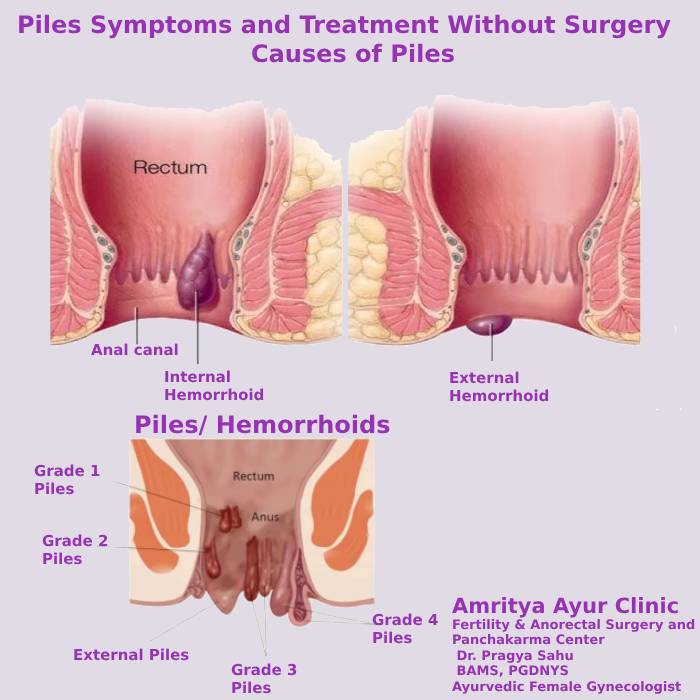Aurvedic Treatment of Piles Without Surgery
amrtiyaayuclinic@gmail.com
Dec 18, 2024 06:54 PM
Piles (Hemorrhoids) are swollen veins in the rectum or anus and can cause discomfort, itching, bleeding, and pain. In women, piles can be triggered or aggravated by various factors. Below are the symptoms, causes, and ayurvedic treatment options for piles without surgery.
Symptoms of Piles in Women
The symptoms of piles can vary, but common signs include:
- Pain and Discomfort: Especially when sitting, standing, or during bowel movements.
- Bleeding: Blood may appear on toilet paper after wiping or in the stool. The blood is typically bright red.
- Itching or Irritation: The anus may feel itchy, which can worsen when sitting for long periods.
- Swelling: A lump around the anus that may be tender to the touch.
- Mucous Discharge: Some women experience a discharge of mucus from the anus.
- Feeling of Fullness: A sensation of incomplete bowel movement.
- Prolapse: Internal hemorrhoids may prolapse (slide out) through the anus.
Causes of Piles in Women
The causes of piles in women are similar to those in men but can be influenced by certain gender-specific factors:
- Pregnancy: The growing uterus can exert pressure on the rectal veins, leading to swollen veins or hemorrhoids. Hormonal changes during pregnancy also increase the likelihood.
- Childbirth: Vaginal delivery, especially if prolonged or involving strain, can increase the risk of developing hemorrhoids.
- Constipation: Chronic constipation leads to excessive straining during bowel movements, which puts pressure on the veins in the anus.
- Diarrhea: Frequent diarrhea or loose stools can also irritate the anal region, causing inflammation and swelling of the veins.
- Obesity: Excess weight places pressure on the pelvic area, contributing to hemorrhoids.
- Sedentary Lifestyle: Sitting or standing for long periods, especially in a sedentary lifestyle, can lead to blood flow issues in the rectal veins.
- Poor Diet: A lack of fiber in the diet can cause constipation, leading to hemorrhoids.
- Hormonal Fluctuations: Hormonal changes during menstruation or menopause can affect circulation and make veins more prone to swelling.
- Age: Hemorrhoids can develop in older women due to the weakening of supporting tissues in the rectum and anus.
- Family History: Genetic predisposition can increase the likelihood of developing hemorrhoids.
Ayurvedic Treatment for Piles (Without Surgery)
Ayurveda focuses on balancing the body’s energies (doshas) and recommends natural remedies to treat piles. Here are some effective ayurvedic approaches:
-
Herbal Remedies:
- Triphala: A combination of three fruits (amla, haritaki, and bibhitaki) that helps in improving digestion, reducing constipation, and cleansing the intestines.
- Arshoghni Vati: An Ayurvedic tablet known for treating piles by reducing inflammation and improving blood circulation in the affected area.
- Kachnar Guggulu: A popular Ayurvedic remedy for reducing swelling and inflammation, it may help in shrinking hemorrhoids over time.
- Pudina (Peppermint): Known for its cooling properties, it can reduce pain and inflammation when applied to the affected area.
- Guggul: It is used for its anti-inflammatory properties, reducing the swelling in the anal region.
-
Dietary Changes:
- Increase Fiber Intake: Consuming more fruits, vegetables, and whole grains can soften stools, reducing the need for straining during bowel movements.
- Hydration: Drinking plenty of water helps in preventing constipation and maintaining regular bowel movements.
- Avoid Processed Foods: Foods that are highly processed, spicy, or fatty can worsen constipation and lead to piles.
-
Topical Applications:
- Neem: Neem has antibacterial and anti-inflammatory properties. It can be applied as a paste to the anal area to reduce inflammation.
- Aloe Vera: Applying aloe vera gel can soothe the affected area and reduce irritation and inflammation.
- Warm Sitz Baths: Sitting in warm water for 15-20 minutes can reduce pain, itching, and inflammation around the anus.
-
Lifestyle Modifications:
- Exercise Regularly: Engaging in physical activity helps improve blood circulation and digestion, reducing constipation.
- Avoid Prolonged Sitting: If sitting for long hours, make sure to take breaks and move around to promote blood flow to the lower body.
- Avoid Straining: Never strain during bowel movements. If needed, consider using a footstool to elevate your feet, as this can change the angle of the rectum and reduce straining.
-
Yoga: Certain yoga postures can improve blood flow, relieve constipation, and reduce the pressure on the rectal veins. Some useful poses include:
- Paschimottanasana (Seated Forward Bend): Helps to stimulate the digestive organs.
- Pavanmuktasana (Wind-Relieving Pose): Relieves constipation and improves digestion.
- Setu Bandhasana (Bridge Pose): Improves blood circulation to the pelvic area.
-
Ayurvedic Oils and Pastes:
- Brahmi Oil: Known for its anti-inflammatory properties, it can help soothe irritation.
- Sesame Oil: It is traditionally used in Ayurveda to treat hemorrhoids because of its healing properties when applied externally.
- Mustard Oil: Used in some Ayurvedic treatments to reduce swelling and promote healing.
Prevention Tips:
- Maintain a high-fiber diet to prevent constipation.
- Stay hydrated by drinking enough water throughout the day.
- Avoid sitting or standing for long periods; take regular breaks.
- Maintain a healthy weight to reduce pressure on the rectal veins.
- Practice good hygiene to avoid further irritation around the anus.
Conclusion:
Ayurvedic treatment for piles focuses on natural healing by balancing doshas, improving digestion, and reducing inflammation. By incorporating lifestyle changes, herbal remedies, and diet modifications, most cases of piles can be managed without the need for surgery. However, if symptoms persist or worsen, it is important to consult a healthcare provider for further evaluation and treatment.
Get best piles treatment without surgery in Amritya Ayur Clinic
